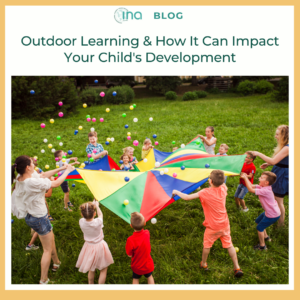 A child’s early learning experiences come from many different things. One-on-one instruction, imaginative play indoors, and hands-on exploration and learning outside are all ways that promote creativity and foster brain development. Here, we’ll explore some of the benefits of outdoor learning and how it can engage children in a unique way.
A child’s early learning experiences come from many different things. One-on-one instruction, imaginative play indoors, and hands-on exploration and learning outside are all ways that promote creativity and foster brain development. Here, we’ll explore some of the benefits of outdoor learning and how it can engage children in a unique way.
Enhanced physical health.
We all know how active children can be and getting outdoors to learn and explore is one of the best ways to encourage movement. With larger outdoor spaces for children to run, play, and explore, their physical health is improved. Running, jumping, and climbing are all great for developing motor skills and cultivating strong muscles and bones. It also helps improve heart health and assists in maintaining healthy weights. And when bodies are healthy, minds have more opportunities to learn, retain information, and flourish.
Stimulates the senses.
Nature is full of sights, smells, and sounds. Getting children outside to experience those things creates a vibrant and engaging environment to learn.
Greater attention and cognitive ability.
Free play is crucial to a child’s development. While indoor free play is wonderful, outdoor play has different sensory stimuli and physical components that can assist with enhanced attention and better cognitive function.
Creates interest in new topics.
Being outside can spark curiosity. Maybe seeing the way that nature interacts with each other opens up topics or interests that they haven’t thought of before. For example, how long do trees live and how do they stay healthy? What is the wind? How does sunlight impact plant and flower growth? Encourage them to ask questions and then work together to find answers.
Minimized stress and anxiety.
The world can be chaotic and stressful, and kids can sense these things. Being outside to learn and explore gives them the opportunity to immerse themselves in nature – and this has a calming effect on kids. This can help reduce symptoms of anxiety or stress.
Encourages imagination.
Kids love to imagine and create. Outdoor environments are conducive to imagination, too. For example, grabbing sticks, leaves, plants, sand, or stones can ignite stories and transform playtime activities that indoor activities can’t do.
Spending time outdoors is also great for teaching children how to respect and care for nature. It develops a deeper connection to the Earth and our environment.
Being outdoors is imperative to any human being’s health and well-being, helping improve our cognitive, physical, social and emotional health!
